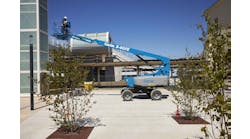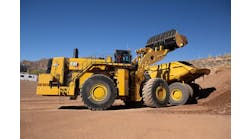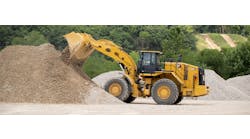Westport, Conn.-based Terex Corp. last week announced a net loss for the second quarter of 2009 of $77.6 million, or $0.78 per share, compared to net income of $236.3 million, or $2.32 per share, for the second quarter of 2008. Net sales were $1.32 billion in the second quarter of 2009, a decrease of 55 percent from $2.94 billion in the second quarter of 2008.
Adjusting for the translation effect of foreign currency exchange rate changes, net sales decreased approximately 49 percent from the comparable prior-year period. During the second quarter of 2009, the company incurred after-tax charges of $31.4 million, or $0.32 per share, associated with restructuring programs and a continued reduction in production levels. Additionally, as previously disclosed, the company and the U.S. Securities and Exchange Commission staff have reached a tentative agreement in principle to resolve the SEC’s concerns, which would require, among other things, that the company pay a penalty. Accordingly, a charge of $8.0 million, or $0.08 per share, was taken during the second quarter of 2009 in anticipation of the proposed settlement with the SEC, which is still subject to SEC and court approval. All per-share amounts are on a fully diluted basis.
“The turmoil from the ongoing recession continues to deeply impact sales for our industry,” said Ron DeFeo, Terex chairman and CEO. “Certain markets have stabilized, but at low levels, such as aerial work platforms and materials processing. Other markets, such as mining and large capacity cranes, have begun to weaken, but at less dramatic rates. We are responding by aggressively reducing costs. Manufacturing spending in the second quarter of 2009 was down 49 percent from the second quarter of 2008 and 16 percent sequentially from the first quarter.
“We are still managing the company for cash, and we made good progress this quarter. Our capital markets activity this quarter, plus cash generated from operations, resulted in an improved liquidity position with cash and borrowing availability of approximately $939 million and $486 million, respectively, at June 30. We believe that we are increasingly well positioned to weather the current economic storm.”
Net sales in the quarter were $1.32 billion, a decrease of $1.62 billion, or 55 percent, from $2.94 billion in the second quarter of 2008. Each of the company’s segments experienced lower net sales due to the global economic uncertainty that has caused customers to remain very cautious about purchasing equipment. Approximately $175 million of the net sales decrease was due to the translation effect of foreign currency exchange rate changes, primarily the strength of the U.S. Dollar relative to the Euro, British Pound and Australian Dollar.
Backlog for orders deliverable during the next 12 months was $1.65 billion at June 30, a decrease of 60.9 percent from June 30, 2008, and a decrease of 16.7 percent from March 31. The decrease in backlog reflects lower net order intake across each of the company’s segments.
The company currently expects its 2009 net sales to decline approximately 50 percent when compared with 2008, approximately 7 percent of which is due to the estimated translation effect of foreign currency exchange rate changes. Previous guidance was for 2009 net sales to decline in the range of 40 to 45 percent, which included an estimated translation effect of foreign currency exchange rate changes of approximately 14 percent. The anticipated further decline in net sales reflects weak global end-markets combined with continued constrained credit availability worldwide.
The impact of restructuring activities is expected to result in improved financial results for the second half of 2009; however, the current end-market demand for machinery in general makes it unlikely that the company will be profitable, excluding charges relating to ongoing restructuring activities, in the second half of 2009.
“We are continuing to operate through some very challenging times, said Tom Riordan, Terex president and chief operating officer. “Our factories are working on reduced schedules, with a build-to-order approach, as we aggressively manage our business to further reduce inventory levels. During the second quarter, inventory reductions generated cash of approximately $278 million, and we are working toward exceeding our $500 million target for the year. We anticipate that further cost savings initiatives will need to be undertaken in order to eliminate operating losses by the end of 2009 in our most challenged businesses. However, for our AWP business specifically, we may not see operating profitability until the demand environment improves, which in our estimate may not occur for another 12 months.
“The Construction segment generated a large operating loss during the second quarter, as additional restructuring activities resulted in substantial charges. We are addressing the problems of dramatic net sales reductions as rapidly as possible. At some operating locations, headcount reductions have taken longer to implement than we would have liked, but we will make the necessary changes in the near term. Many of the headcount actions for which restructuring charges have already been incurred will be made effective during the third quarter, and should result in improved income statement performance through the balance of 2009 and into 2010.”
Net sales for the AWP segment for the second quarter of 2009 decreased $545.5 million, or 72.2 percent, to $209.9 million versus the second quarter of 2008. Rental customers continue to age and reduce their fleets, and as a result, are deferring the purchase of new aerial and telehandler products. The core markets for aerials in North America and Europe remain at very depressed levels. The Utility business is continuing to see similar levels of order inquiries when compared with the comparable period in 2008.
Net sales for the Construction segment for the second quarter of 2009 decreased $471.1 million, or 68.2 percent, to $219.9 million versus the second quarter of 2008. Global weakness negatively impacted the net sales volume of the entire Construction segment. Most Construction segment businesses have made progress reducing their inventory, especially finished goods inventory in the dealer channel. However, the environment remains challenging as dealers continue to be reluctant to invest in stock inventory for their dealerships and the tightness of commercially available credit continues to impact the ability to finance projects and equipment.
Net sales for the Cranes segment for the second quarter of 2009 decreased $342.8 million, or 41.1 percent, to $491.0 million versus the second quarter of 2008. Rough-terrain and tower crane net sales during the second quarter of 2009 were at levels substantially below those achieved during the second quarter of 2008, as commercial construction projects were postponed or halted and oil-related energy demand for rough-terrain cranes slowed. High-capacity crawler and all-terrain cranes continue to be needed for infrastructure projects and energy-related projects such as wind power and power plant construction, although there has been some softening of demand in the lower capacity all-terrain crane market.
Terex Corp. is a diversified global manufacturer with 2008 net sales of $9.9 billion. Terex operates in four business segments: Terex Aerial Work Platforms, Terex Construction, Terex Cranes, and Terex Materials Processing & Mining.





